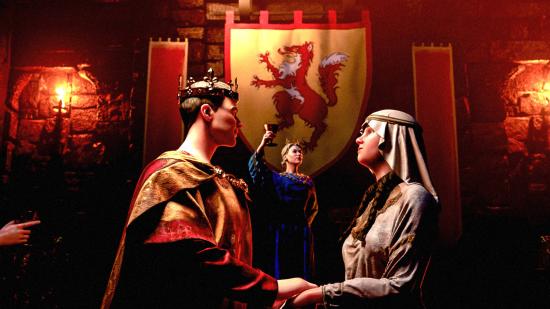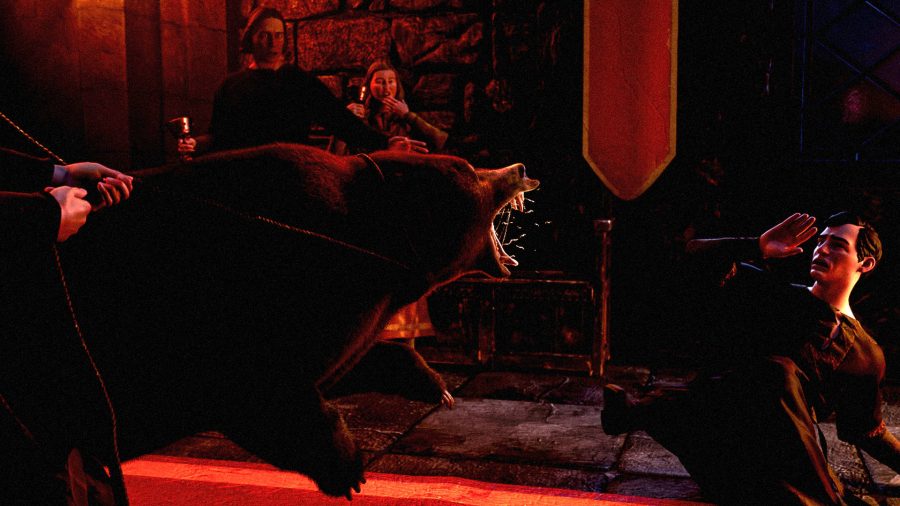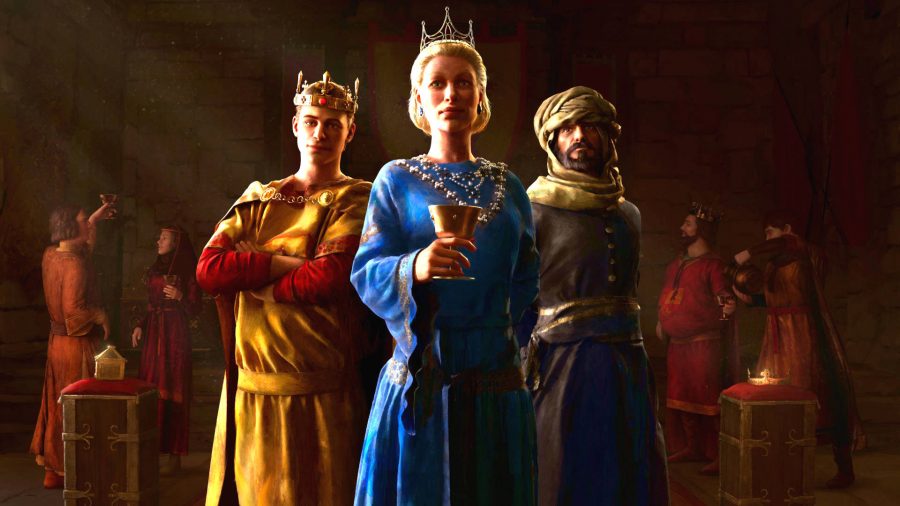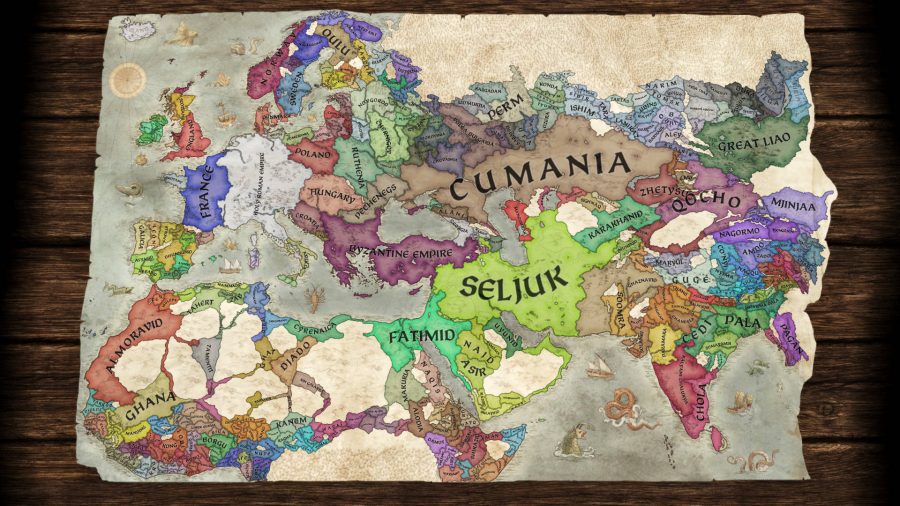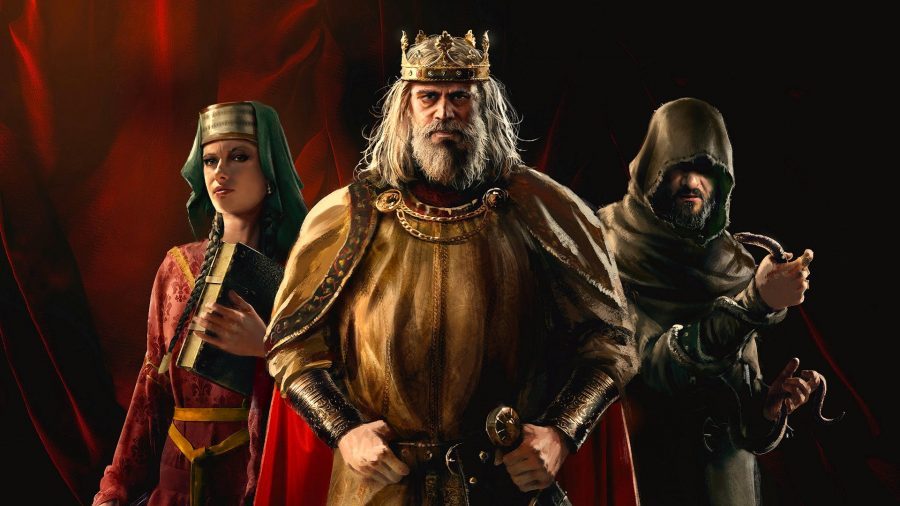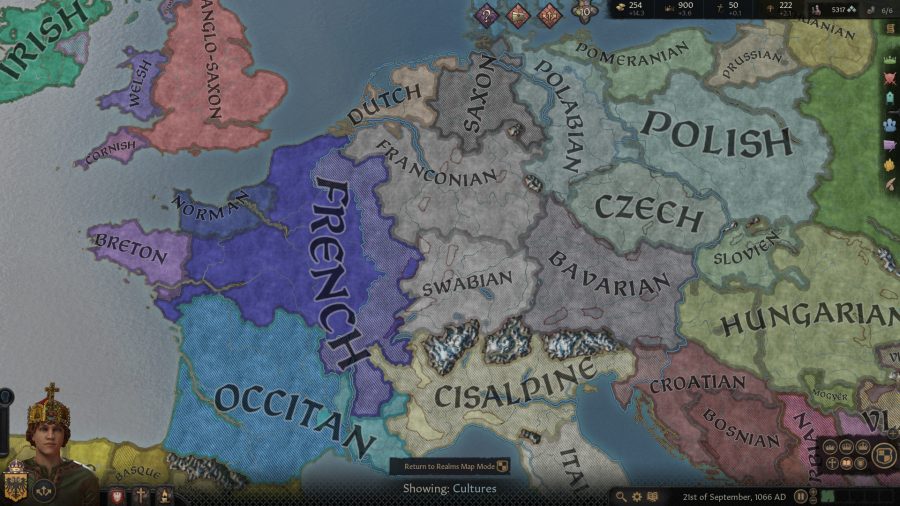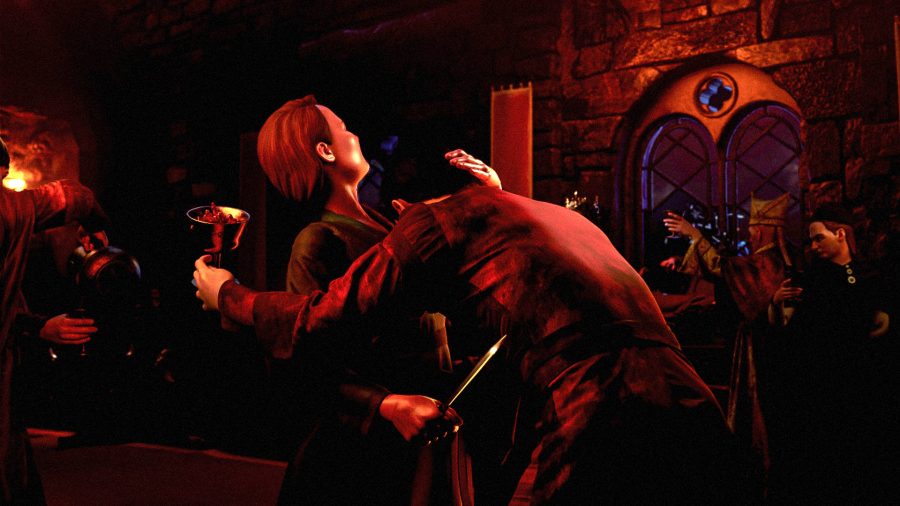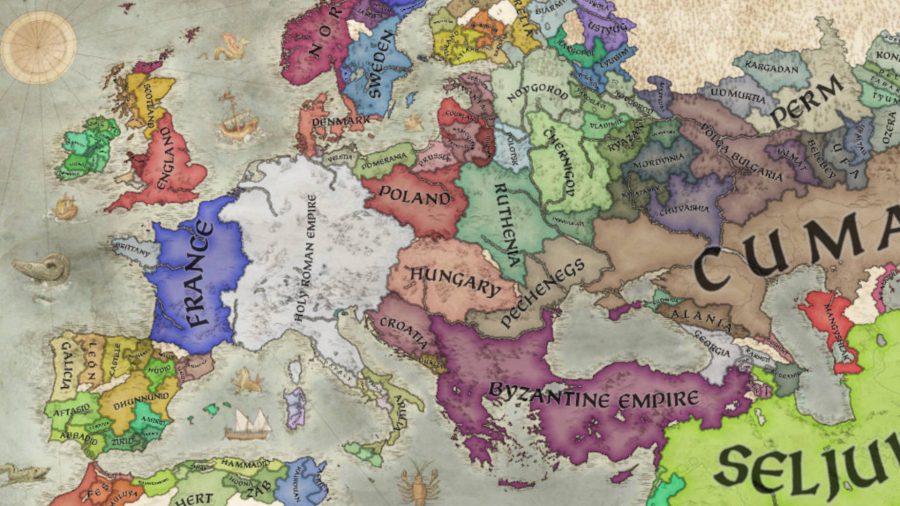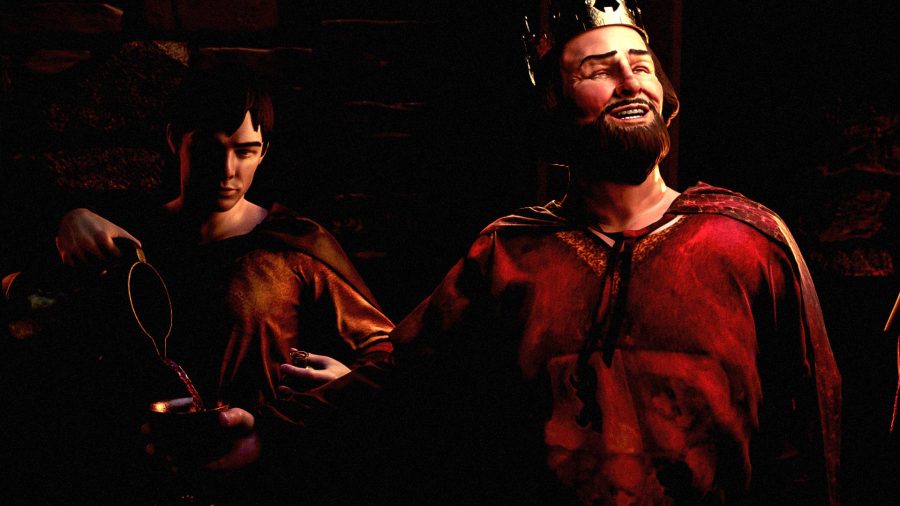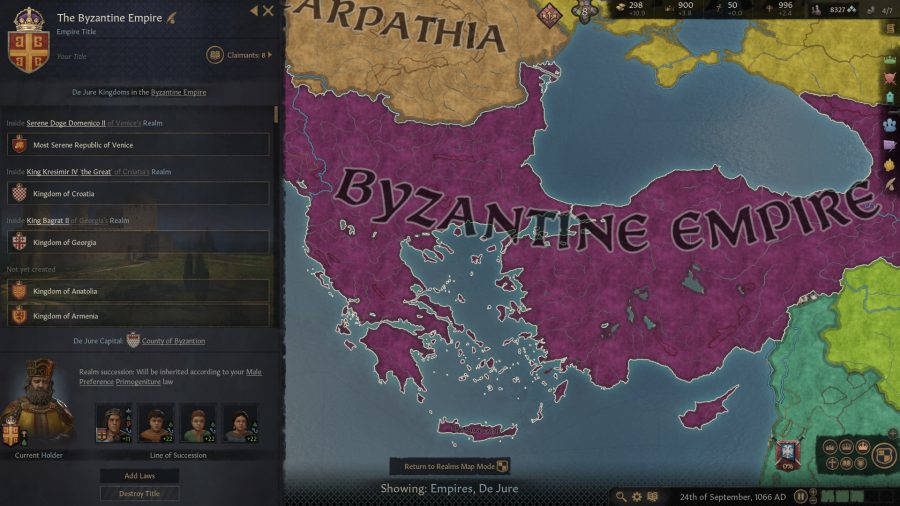It might possess wide acclaim and mainstream success, but Crusader Kings 3 is still the baby of publisher Paradox Interactive’s growing grand strategy family. Far from boasting the thick DLC catalogue of Europa Universalis, or its WW2 cousin Hearts of Iron 4, the hybrid medieval nation-simulator-RPG’s first major expansion was announced last week. And this time, it’s culture, and the King’s quarters, that are on the table.
Royal Court’s most prominent feature is the addition of a throne room. A new mechanic, which only the grandest of Kings, Emperors, and the highest rulers may access, it’s intended as a means of interacting with your courtiers and vassals, while accumulating the newly-added Grandeur stat, as you frivolously show off your wealth. Elsewhere, CK3’s culture system is being massively overhauled, allowing players to merge separate groups through ‘hybridisations’, cherry-picking their best aspects to create a favoured cultural combination.
As is standard for Paradox games, Royal Court will be accompanied by a free update, which restructures the game’s culture system, adding new compositional hierarchies to its interface, and is designed to go hand-in-hand with the upcoming DLC.
We speak to Alexander Oltner, game designer on Crusader Kings 3, about the joys of sitting majestically upon your throne, how culture can be restructured, and what wacky combinations players might make using the hybridisation system.

Wargamer: The most prominent feature of the Royal Court DLC is the new throne room, which Kings and powerful rulers can unlock. How will players use the throne room in-game?
Alexander Oltner: It’s a new hub, essentially. It’s not just a graphical scene, but ties together with so many features in the game. It was intended as a bridge between your character and the map, because you never got to see your ruler ruling, or in context with other characters, in an actual place. We’ve always had references to things such as your throne room, but it’s always been abstract in a way that doesn’t sit well with me. The idea was to bridge this gap. It’s a medieval game, and what is more medieval than a ruler in their throne room?
You have the throne room scene, which is there to immerse you in where you are, and what you’re doing. It shows off all the court artefacts you’ve collected, but there’s going to be events that happen in this room, to give you a reason to regularly go back into it. It’s a type of flavour event, that we call a ‘court event’, that’s exclusively between your courtiers.
There might be people fighting or friendships forming. Or there might be someone holding a court position wanting to do something for you, or requesting something. If this times out, not much will happen. But maybe something might happen, so you’ll want to go in and see what’s going on.
So the throne room is intended as a way of handing more decisions and actions to the player?
AO: The entire royal court feature is designed to reward the player for ascending to these ranks, and being a King or Emperor. If you start out as a count, duke, or tribal ruler, the game isn’t going to be that different for you. But when you either become a king, or you reform your tribal society to a feudal one, you get these new toys to play with that are, by and large, based on what mediaeval rulers actually had to care about.
Monarchical might: Read our Crusader Kings 3 guide
There’s some visual variety to the throne rooms. How do they differ between rulers?
AO: The room itself can be in four different styles. We have the Western style court, a Mediterranean style court, a Middle Eastern, and an Indian court because these are the major areas of the map that have this type of architecture; this royal court thing going on. Tribal rulers do not use this. They’re in a different stage where money is important, but spending money, which is so central to this royal court feature, isn’t necessarily part of what they do. They use Prestige, and are more warlike by nature.
The update will add a personal inventory system for your ruler, how similar will it be to that in CK2?
AO: The inventory is essentially an evolution of the one that was in CK2. You can have weapons, clothes, crowns, and trinkets. The weapon is shown on your actual model, and when you’re in duels, for example, you will see yourself holding your weapon, or the closest thing to it. We have quite a few different models and quite a few different types of weapons. And a few different animations as well, because that’s really fun.
They provide bonuses for various things, like a book on how to learn a language can give you a little boost to scheme power. But the items themselves have a durability. This is different from how it works in CK2, when they were randomly destroyed. Durability drops with time, and items can be reforged by spending money. But we didn’t want items to feel so permanent. If you have your grandfather’s sword 150 years after it’s forged, to do that you need to invest quite heavily into the item itself, if it’s even possible by that point.
‘Grandeur’ is a new resource added in the DLC that incentivises frivolity. What was the idea behind adding another currency to the game?
AO: It’s easy to play or imagine this world as one of perfect rationality. The ruler has a pile of gold, all their vassals pay them gold, and they use it exclusively on warfare, building buildings, or soldiers and maintenance. But they had to spend money on frivolous things to keep up their image. And that’s where the concept of Grandeur comes in.
Grandeur has effects. It’s divided into levels, one to ten, and all of them unlock something for you. The first thing you unlock is the ability to ‘hold court’, and along the way to the last few, you unlock things such as new council jobs, that give you more power to do things. But Grandeur is not similar to prestige. It’s not a currency you spend; it’s more of a balancing act. The value itself is between zero and 100, you don’t necessarily want to be at 100, just as little as you want to be at zero. It’s always good to have more Grandeur, but having more is also extremely expensive.
It would be easy to say, ‘I’m not gonna spend anything on Grandeur. I will spend all my money on war’. And to that end, we have something called Expectations. Depending, mostly, on how large your realm is, you’ll have an Expectation put upon you by your peers. If you undershoot this Expectation, you’ll suffer quite hefty diplomatic penalties: your vassals will like you less, foreign rulers will like you less, you gain less prestige, less renown, all of that.
The free update is restructuring CK3’s culture system. Why did the existing system need to be changed?
AO: Cultures used to be nothing more than a container for a name list. That’s really all they were. They had static opinions towards every other culture. If you were in the same group, you had a lesser penalty than if they were outside of your group. Very rudimentary. We wanted to make this system more exciting, give it more opportunity for flavour, tie more rules into culture, and also expose the invisible things that culture gave you.
Now, every culture has an Ethos, out of seven possible options. By themselves, they don’t do much, but have some modifiers affecting various things. Then, there are Pillars, which every culture has to take. The Pillars are its language, its heritage, aesthetics (of name, clothing. architecture, units, and coat of arms), and noble martial tradition.
Game changer: These are the best Crusader Kings 3 mods
Traditions are the building blocks; this is the fun stuff. Hypothetically, a culture could have no traditions, but they’re the things that make the culture stand out. There’re many different traditions, and we’ve added more stuff to make them interesting, and stand apart from each other.
One of my favourites is isolationism, which makes the culture extremely unlikely to interact outside of its own. AI characters will simply not marry outside their own culture, and if the player tries to do it, they will get a marriage penalty. The courtiers of the culture are less likely to wander away. It lowers diplomatic range a little bit, but it also makes it easier to control your own lands.
The new system is intended to make cultures less static. How will a culture’s change over time?
AO: This is where the system comes together. The culture head normally adds traditions up to the limit. But these traditions have prerequisites. Some of them are based on logic, like you can’t add jungle warriors to the Saxon culture, because it’s not present in any jungle. And there’s a cost associated with these traditions. One is based on the ethos: how compatible is this tradition to the ethos, and then there’s an element of how suitable this tradition is for this culture.
This means that the player can technically add whatever they want, as long as they’re willing to wait for long enough, or spread the culture into new lands. But it’s very hard. We don’t want to block the player from doing what they think is fun. The AI, on the other hand, will most often pick something fairly cheap or something that makes sense. If it’s a culture with lots of coastal provinces, it might add some sort of fishermen or naval embarkation tradition.
The new system of cultural hybridisation allows players to merge existing cultures together, and create a new culture that bridges both. Is this a ticket to crazy cultural combinations, or will there be an incentive to merge?
AO: It’s definitely the ticket to crazy combinations if that’s what you want. The game is quite wild sometimes, but we’re trying to still make it feel logical. Every culture has an acceptance level towards every other culture. This is on a scale of zero to 100, where zero is completely unaccepting of each other, and the 100 is we’re essentially the same culture.
To hybridise, you need a certain level of acceptance. You can’t just force two cultures to meld together, since that makes no sense. So, you need to build up this acceptance, and you can do this in many different ways. You can grant titles, you can let characters of the culture rule their own land, you can have two cultures border each other. And if you’re in a pinch, you can use a Steward job called ‘increase acceptance’. Then you have to avoid doing things, such as going into war with the rulers of the culture, or revoking titles.
When you reach this acceptance threshold, you can choose to form a hybrid culture. You can pick Pillars from both, and some of their Traditions. You can form some powerful cultures, and hybridise a hybrid culture. It’s fun, and we don’t want to block the player from having fun, but the AI will be way more restricted with this. We don’t want to break the player’s immersion.
Is the hybridisation system an attempt to make CK3 more historically accurate, by reflecting the changing cultures of history, or an attempt to lean into the wacky side of the game, by supporting weird player-led creations?
AO: It’s definitely there to represent history. The static nature of cultures in the game, where the only opportunity you have is to culture-convert provinces, is not at all how it happened historically. The medieval era was an era of change, cultures diverged, and they melded together constantly. We try to keep it restricted in the game, so not everything diverges, or hybridises all the time. But I think the most historical thing would be to have every single culture have diverged by the end of the game.
Jump ahead: Check out our Hearts of Iron 4 tutorial
Medieval French is not modern French. It’s a constant evolution; regionalization and isolation. If you imagine a player that doesn’t lean into the wacky side of the game, they would likely still want to diverge or hybridise their culture, if they end up in a situation where it makes sense for them to do so. It’s very historical, and you can drive that historical change.
Or you can go crazy, and be as wacky as you like. You can hybridise cultures over, and over, and over again, having more and more hyphens, making it an incredible mouthful to pronounce.
Was the hybridisation system designed to follow a historic route, or is it more a case of letting the procedural nature of the game take over?
AO: It’s an abstraction of many things that happened during the era. One of the most famous examples is Normans and Anglo Saxons eventually becoming English. But there are plenty of other examples across the map, all with a common denominator that there should be at least some level of acceptance between the cultures. You can’t just force a hybridisation, as that would be something like the Anglo Saxon lands ruled by Normans. That’s just rulership of one culture over another.
We had quite a few thoughts behind this when we developed the hybridisation system itself: what happened historically, and how can we represent this in a fairly accurate way, while still keeping it somewhat character-focused. And that’s a key concept in the game. Everything should be driven by the characters, in one way or another.
How are cultural combinations represented in-game?
AO: Immersion- and flavour-wise, they get new names, and you can name your new culture yourself if you like. You can choose its colour on the map, which is actually the first time we allow you to choose your colour on the map in CK, and when you’re hybridising cultures, you can choose to use the clothing of one of the cultures, or choose to use both to create a hybrid fashion.
It’s not realistic for us to dynamically generate a character name list that’s a mash-up of both, but we do allow you to use both named lists. So you have both Bedouin and Greek names, for example, and the same with coat-of-arms. It’s a fun flavour thing.
What are you most excited about in the DLC and update?
I love both of the two main features. I love the royal court because it ties the characters closer together, and ties the character more to the map, giving you this medieval immersion that you didn’t have before. Now you have to be this frivolous spender on nonsense. I love that, for the temporal, here-and-now gameplay.
While I love the cultures and the hybridisation for the reason of seeing the map evolve over time. I love seeing what has happened from the start of the game to the end of the game, and the new cultures make that so much more exciting; so much less static.
